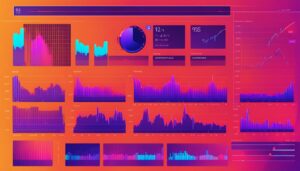Welcome to our guide on algorithmic trading! In today’s fast-paced financial markets, traders are constantly seeking innovative ways to gain a competitive edge. Algorithmic trading, also known as automated trading, has emerged as a game-changer in the trading world. Let’s explore the essentials of algorithmic trading and how it can empower traders like you to make more informed and efficient trading decisions.
Algorithmic trading involves using computer programs to execute trades based on predefined instructions or algorithms. This approach enables traders to capitalize on profit opportunities at a speed and frequency that would be impossible for a human trader. The algorithms can be designed to take into account various factors such as timing, price movements, quantities, or even mathematical models.
By relying on trading algorithms, traders can eliminate emotions from the trading process, ensure efficient trade execution, and reduce transaction costs. Popular algorithmic trading strategies include trend-following, arbitrage, and index fund rebalancing. However, to get started with algorithmic trading, traders need access to computers, networks, financial market knowledge, and coding capabilities.
Key Takeaways:
- Algorithmic trading, also known as automated trading, uses computer programs to execute trades based on predefined instructions.
- It allows traders to capitalize on profit opportunities at a speed and frequency that would be impossible for a human trader.
- Algorithmic trading strategies aim to strip emotions out of trades, ensure efficient trade execution, and reduce transaction costs.
- Trend-following, arbitrage, and index fund rebalancing are common algorithmic trading strategies.
- To engage in algorithmic trading, traders need computer access, network access, financial market knowledge, and coding capabilities.
How Algorithmic Trading Works
Algorithmic trading is a trading strategy that utilizes computer programs to monitor stock prices and execute trades automatically based on predefined conditions. By eliminating the need for manual monitoring and order placement, algorithmic trading allows traders to quickly identify and seize trading opportunities.
One of the key components of algorithmic trading is the use of trading strategies encoded into computer programs. These strategies are designed to determine when to enter or exit trades, and can be based on various factors such as technical indicators, market trends, or mathematical models.
For example, a common algorithmic trading strategy involves using moving averages as indicators. A trader may set up a program that buys a certain number of shares when the stock’s 50-day moving average crosses above its 200-day moving average, and sells the shares when the 50-day moving average crosses below the 200-day moving average. The computer program continuously monitors the stock price and moving average indicators, and when the conditions are met, it automatically places the buy or sell orders.
“Algorithmic trading allows traders to capitalize on trading opportunities at a speed and frequency that would be impossible for a human trader.”
With algorithmic trading, traders can take advantage of trading opportunities without the need for constant manual monitoring. The computer program can scan the market for potential trades, analyze data, and execute orders in fractions of a second. This not only increases the efficiency of trade execution but also reduces the impact of emotions, biases, and human errors often associated with manual trading.
Algorithmic trading, therefore, offers traders the potential to maximize trading opportunities and optimize trading performance.
| Advantages of Algorithmic Trading | Disadvantages of Algorithmic Trading |
|---|---|
| 1. Increased speed and efficiency in trade execution | 1. Dependence on technology and potential technical failures |
| 2. Reduction of human errors and emotions in trading | 2. Market disruptions and black swan events |
| 3. Ability to backtest and optimize trading strategies | 3. Impact of large algorithmic trades on market prices |
| 4. Lower transaction costs and improved trade prices | 4. Regulatory requirements and oversight |
Despite the advantages, it is important to consider the potential disadvantages of algorithmic trading as well. Technical failures or glitches in the computer programs can disrupt trading operations and result in financial losses. Market disruptions or unforeseen events can also impact algorithmic trading strategies, leading to unexpected losses.
Furthermore, the impact of large algorithmic trades on market prices is a concern, as it can affect the overall market stability and liquidity. Algorithmic trading is also subject to regulatory requirements and oversight, as regulators strive to ensure fair and efficient markets.
“While algorithmic trading offers numerous benefits, it is crucial for investors to carefully design and monitor their strategies to mitigate potential risks and maximize trading success.”
Advantages and Disadvantages of Algorithmic Trading
Algorithmic trading, also known as automated trading, has become increasingly popular in the financial markets. This approach offers traders several advantages that contribute to their success.
One of the key advantages of algorithmic trading is the ability to achieve best execution of trades. Algorithms can analyze market conditions in real-time and execute trades at the best possible prices without delay. This facilitates optimal trade execution and helps traders maximize their profits.
Additionally, algorithmic trading provides traders with low latency or quick trade order placement. With algorithms, trades can be executed within microseconds, allowing traders to take advantage of fleeting opportunities in the market.
Another advantage of algorithmic trading is the ability to reduce transaction costs. By automating the trading process, algorithms can optimize trade execution and minimize slippage, thereby reducing transaction costs for traders.
Algorithmic trading also enables traders to perform backtesting, which involves evaluating trading strategies using historical and real-time data. This allows traders to assess the viability of their strategies and make data-driven decisions, increasing their chances of success.
However, it is important to consider the disadvantages that come with algorithmic trading. One significant disadvantage is the dependence on technology. Algorithmic trading relies heavily on computer systems and networks, and any technical issues or failures could disrupt trading operations and lead to significant losses.
Another drawback is the potential impact of unforeseen market disruptions or black swan events. Algorithmic trading strategies may not be equipped to handle extreme market conditions, and during such events, traders may experience substantial losses.
Furthermore, algorithmic trading lacks human judgment and may overlook subjective factors that can influence market movements. This reliance on algorithms alone can limit the effectiveness of trading strategies and increases the vulnerability to market volatility.
Lastly, algorithmic trading requires adherence to regulatory requirements and oversight. Traders must ensure that their algorithms comply with market regulations to avoid legal consequences and reputational damage.
In conclusion, algorithmic trading offers numerous advantages, including best execution, low latency, reduced transaction costs, and the ability to backtest strategies. However, traders must also consider the drawbacks, such as dependence on technology, vulnerability to market disruptions, and the lack of human judgment. Striking a balance between utilizing algorithms and incorporating human expertise is crucial for successful algorithmic trading.
FAQ
What is algorithmic trading?
Algorithmic trading, also known as automated trading or algo-trading, involves using computer programs to execute trades based on predefined instructions or algorithms.
How does algorithmic trading work?
Algorithmic trading works by using computer programs to automatically monitor stock prices and execute trades based on predefined conditions.
What are some common algorithmic trading strategies?
Some common algorithmic trading strategies include trend-following, arbitrage, and index fund rebalancing.
What are the advantages of algorithmic trading?
Algorithmic trading offers advantages such as best execution of trades at the best possible prices, low latency, reduced transaction costs, automated checks on market conditions, and elimination of human errors and emotions.
Can algorithmic trading be backtested?
Yes, algorithmic trading can be backtested using historical and real-time data to evaluate the viability of trading strategies.
Are there any disadvantages to algorithmic trading?
Yes, there are several disadvantages to consider, including the need for fast execution speeds, vulnerability to market disruptions and technical issues, potential market impact, regulatory requirements, high capital costs, limited customization options, and the lack of human judgment.
Source Links
- https://www.quantstart.com/articles/Top-5-Essential-Beginner-Books-for-Algorithmic-Trading/
- https://ibkrcampus.com/ibkr-quant-news/algorithmic-trading-strategies-basics-to-advanced-algo-trading-strategies/
- https://www.investopedia.com/articles/active-trading/101014/basics-algorithmic-trading-concepts-and-examples.asp





